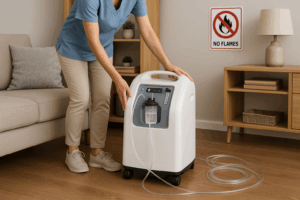Mold in warehouses isn’t just an unsightly problem—it’s a major operational risk. Whether you’re storing food, textiles, electronics, or pharmaceuticals, unchecked mold growth can devastate inventory, jeopardize employee health, and trigger costly business disruptions. Warehouse managers and owners must take proactive measures to tackle mold before it wreaks havoc on your supply chain and bottom line.
In this post, we’ll explore how mold develops in warehouses, the hidden dangers it poses, and effective strategies for detecting, preventing, and eliminating mold. Let’s dive in and ensure your warehouse remains a safe, efficient, and mold-free environment.
How Mold in Warehouses Develops: The Perfect Storm
Mold thrives when moisture, warmth, and organic material collide. In the vast, varied environment of a warehouse, several factors create the perfect storm for mold growth:
- High Humidity Levels: When humidity soars—especially above 60%—mold finds a friendly habitat.
- Water Leaks: Roof or plumbing leaks, as well as condensation on surfaces, contribute to a moist environment that mold loves.
- Poor Ventilation: Inadequate airflow can trap moisture, creating dark, humid pockets perfect for mold proliferation.
- Improper Storage: Overcrowded storage or stacking goods too tightly can inhibit air circulation, trapping moisture against your inventory.
By understanding these triggers, you can begin to implement strategies that disrupt mold’s ideal conditions before it becomes a widespread issue.
The Hidden Dangers: How Mold Affects Inventory & Business Operations
Mold’s impact on warehouses goes far beyond cosmetic damage. Here’s what it can do:
Product Contamination
- Quality Degradation: Mold can seep into packaging, raw materials, and finished products, rendering your inventory unsellable.
- Health & Safety Concerns: Contaminated products, especially in food and pharmaceuticals, pose serious health risks and can trigger recalls.
Financial Losses
- Direct Damage: Costs incurred from replacing spoiled or damaged inventory can quickly add up.
- Operational Disruptions: Mold outbreaks may force temporary shutdowns for remediation, halting operations and delaying shipments.
- Legal & Insurance Claims: Unresolved mold issues can lead to liability claims and increased insurance premiums.
Health & Safety Risks
- Employee Exposure: Prolonged exposure to mold spores can lead to respiratory issues, allergies, and other health complications among your workforce.
- Workplace Safety: A mold-infested environment not only risks employee health but can also compromise the overall safety standards of your facility.
Reputation Damage
- Supply Chain Disruptions: Delays caused by mold-related issues can tarnish your reputation with clients and partners.
- Loss of Trust: Consistent quality issues from mold damage may lead customers to question your facility’s ability to safely store goods, affecting long-term business relationships.
Spotting Trouble: Signs of Mold Infestation in Warehouses
Early detection is key. Here are some signs that mold might be lurking in your warehouse:
Visual Indicators
- Discoloration: Look for unusual patches—black, green, or white—on walls, ceilings, shelving, or even on the inventory itself.
- Surface Damage: Mold can cause peeling paint, deteriorating walls, and damaged storage units.
Odd Odors
- Musty Smells: A persistent damp, earthy odor is a classic sign of hidden mold growth. Trust your nose—if it smells off, investigate further.
Humidity & Moisture Levels
- Rising Readings: Use hygrometers to monitor relative humidity. Consistently high readings (above 60%) can signal the conditions mold needs to thrive.
What to Do: Preventing & Eliminating Mold in Warehouses
Preventing mold in your warehouse requires a multi-pronged approach that addresses both environmental factors and operational practices.
Climate Control Solutions
- Dehumidifiers & Air Conditioning: Invest in industrial-grade dehumidifiers to keep indoor humidity in check. Maintain your HVAC systems to ensure consistent, efficient climate control.
- Temperature Regulation: Stable temperatures help reduce condensation and maintain an environment that’s hostile to mold.
Regular Inspections & Maintenance
- Routine Checks: Schedule frequent inspections to catch leaks, condensation, or early mold growth on walls and storage racks.
- Prompt Repairs: Address any water leaks or structural issues immediately to prevent moisture buildup.
Proper Ventilation & Air Circulation
- Upgrade Airflow: Improve ventilation by installing exhaust fans or enhancing your HVAC system. Better airflow reduces moisture accumulation and disperses potential mold spores.
- Open Layouts: Consider reorganizing storage areas to allow for better air circulation between stored goods.
Storage Best Practices
- Elevate Inventory: Store items on raised racks to minimize contact with potentially damp surfaces.
- Mold-Resistant Materials: Use mold-resistant pallets, packaging materials, and even paint in high-moisture areas to add an extra layer of protection.
- Space Optimization: Avoid overcrowding shelves to ensure proper air movement around your inventory.
Professional Remediation
When mold becomes a full-blown issue, it’s time to call in the experts.
- Industrial Mold Removal: Certified professionals, like those at All Nation Restoration, use specialized equipment and techniques to safely eradicate mold and prevent its return.
- Comprehensive Services: From initial assessment to complete remediation, professional services ensure your warehouse is thoroughly cleaned and restored to a safe condition.
Final Thoughts: Protect Your Warehouse & Inventory from Mold
Mold in warehouses isn’t just a maintenance issue—it’s a critical business risk that can lead to financial losses, compromised inventory, and serious health hazards for employees. By implementing proactive mold prevention strategies, you not only protect your products and infrastructure but also ensure smooth operations and a stellar reputation in the supply chain.
Take Action Today:
- Schedule a Warehouse Inspection: Regular evaluations can catch mold before it turns into a costly problem.
- Invest in Climate Control: Industrial dehumidifiers and proper HVAC systems are essential to keeping your warehouse dry.
- Adopt Best Storage Practices: Ensure your inventory is stored safely and with sufficient air circulation.
- Seek Professional Help: For severe mold infestations, trust certified experts like All Nation Restoration to handle the remediation swiftly and effectively.
About All Nation Restoration
All Nation Restoration is your trusted partner in combating water damage, mold, and other hazards in commercial spaces. Serving homeowners, property managers, and businesses in Austin, TX, and surrounding areas, we specialize in water damage restoration, mold removal, fire damage restoration, biohazard cleanup, heavy demolition, and equipment rentals.
Why Choose Us?
- 24/7 Emergency Services: We’re here whenever you need us.
- IICRC-Certified Technicians: Our experts are trained and certified to handle any challenge.
- Free Estimates & Transparent Pricing: Know what to expect with no hidden fees.
- Lifetime Warranty on Workmanship: We stand by our work for as long as you do.
If you suspect mold growth in your warehouse, don’t wait—contact All Nation Restoration today for professional industrial mold removal services and ensure your business keeps running smoothly.
Protect your warehouse, safeguard your inventory, and secure your business’s future by taking mold prevention seriously.







